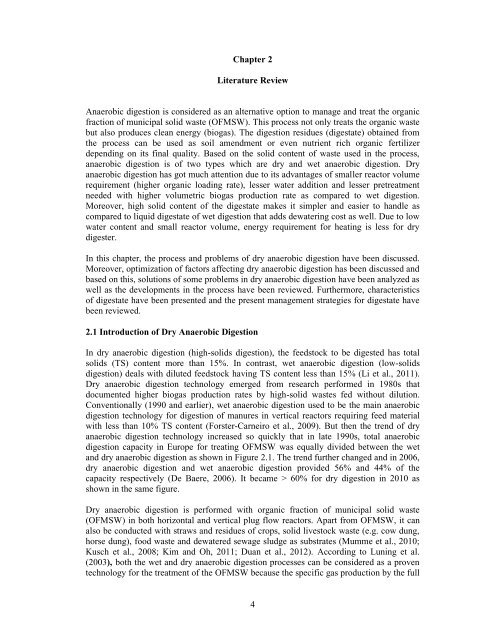dry anaerobic digestion of municipal solid waste and digestate ...
dry anaerobic digestion of municipal solid waste and digestate ...
dry anaerobic digestion of municipal solid waste and digestate ...
Create successful ePaper yourself
Turn your PDF publications into a flip-book with our unique Google optimized e-Paper software.
Chapter 2<br />
Literature Review<br />
Anaerobic <strong>digestion</strong> is considered as an alternative option to manage <strong>and</strong> treat the organic<br />
fraction <strong>of</strong> <strong>municipal</strong> <strong>solid</strong> <strong>waste</strong> (OFMSW). This process not only treats the organic <strong>waste</strong><br />
but also produces clean energy (biogas). The <strong>digestion</strong> residues (<strong>digestate</strong>) obtained from<br />
the process can be used as soil amendment or even nutrient rich organic fertilizer<br />
depending on its final quality. Based on the <strong>solid</strong> content <strong>of</strong> <strong>waste</strong> used in the process,<br />
<strong>anaerobic</strong> <strong>digestion</strong> is <strong>of</strong> two types which are <strong>dry</strong> <strong>and</strong> wet <strong>anaerobic</strong> <strong>digestion</strong>. Dry<br />
<strong>anaerobic</strong> <strong>digestion</strong> has got much attention due to its advantages <strong>of</strong> smaller reactor volume<br />
requirement (higher organic loading rate), lesser water addition <strong>and</strong> lesser pretreatment<br />
needed with higher volumetric biogas production rate as compared to wet <strong>digestion</strong>.<br />
Moreover, high <strong>solid</strong> content <strong>of</strong> the <strong>digestate</strong> makes it simpler <strong>and</strong> easier to h<strong>and</strong>le as<br />
compared to liquid <strong>digestate</strong> <strong>of</strong> wet <strong>digestion</strong> that adds dewatering cost as well. Due to low<br />
water content <strong>and</strong> small reactor volume, energy requirement for heating is less for <strong>dry</strong><br />
digester.<br />
In this chapter, the process <strong>and</strong> problems <strong>of</strong> <strong>dry</strong> <strong>anaerobic</strong> <strong>digestion</strong> have been discussed.<br />
Moreover, optimization <strong>of</strong> factors affecting <strong>dry</strong> <strong>anaerobic</strong> <strong>digestion</strong> has been discussed <strong>and</strong><br />
based on this, solutions <strong>of</strong> some problems in <strong>dry</strong> <strong>anaerobic</strong> <strong>digestion</strong> have been analyzed as<br />
well as the developments in the process have been reviewed. Furthermore, characteristics<br />
<strong>of</strong> <strong>digestate</strong> have been presented <strong>and</strong> the present management strategies for <strong>digestate</strong> have<br />
been reviewed.<br />
2.1 Introduction <strong>of</strong> Dry Anaerobic Digestion<br />
In <strong>dry</strong> <strong>anaerobic</strong> <strong>digestion</strong> (high -<strong>solid</strong>s <strong>digestion</strong>), the feedstock to be digested has total<br />
<strong>solid</strong>s (TS) content more than 15 %. In contrast, wet <strong>anaerobic</strong> <strong>digestion</strong> (low-<strong>solid</strong>s<br />
<strong>digestion</strong>) deals with diluted feedstock having TS content less than 15% (Li et al., 2011).<br />
Dry <strong>anaerobic</strong> <strong>digestion</strong> technology emerged from research performed in 1980s that<br />
documented higher biogas production rates by high-<strong>solid</strong> <strong>waste</strong>s fed without dilution.<br />
Conventionally (1990 <strong>and</strong> earlier), wet <strong>anaerobic</strong> <strong>digestion</strong> used to be the main <strong>anaerobic</strong><br />
<strong>digestion</strong> technology for <strong>digestion</strong> <strong>of</strong> manures in vertical reactors requiring feed material<br />
with less than 10% TS content (Forster-Carneiro et al., 2009). But then the trend <strong>of</strong> <strong>dry</strong><br />
<strong>anaerobic</strong> <strong>digestion</strong> technology increased so quickly that in late 1990s, total <strong>anaerobic</strong><br />
<strong>digestion</strong> capacity in Europe for treating OFMSW was equally divided between the wet<br />
<strong>and</strong> <strong>dry</strong> <strong>anaerobic</strong> <strong>digestion</strong> as shown in Figure 2.1. The trend further changed <strong>and</strong> in 2006,<br />
<strong>dry</strong> <strong>anaerobic</strong> <strong>digestion</strong> <strong>and</strong> wet <strong>anaerobic</strong> <strong>digestion</strong> provided 56% <strong>and</strong> 44% <strong>of</strong> the<br />
capacity respectively (De Baere, 2006) . It became > 60% for <strong>dry</strong> <strong>digestion</strong> in 2010 as<br />
shown in the same figure.<br />
Dry <strong>anaerobic</strong> <strong>digestion</strong> is performed with organic fraction <strong>of</strong> <strong>municipal</strong> <strong>solid</strong> <strong>waste</strong><br />
(OFMSW) in both horizontal <strong>and</strong> vertical plug flow reactors. Apart from OFMSW, it can<br />
also be conducted with straws <strong>and</strong> residues <strong>of</strong> crops, <strong>solid</strong> livestock <strong>waste</strong> (e.g. cow dung,<br />
horse dung), food <strong>waste</strong> <strong>and</strong> dewatered sewage sludge as substrates (Mumme et al., 2010;<br />
Kusch et al., 2008; Kim <strong>and</strong> Oh, 2011; Duan et al., 2012). According to Luning et al.<br />
(2003), both the wet <strong>and</strong> <strong>dry</strong> <strong>anaerobic</strong> <strong>digestion</strong> processes can be considered as a proven<br />
technology for the treatment <strong>of</strong> the OFMSW because the specific gas production by the full<br />
4

















